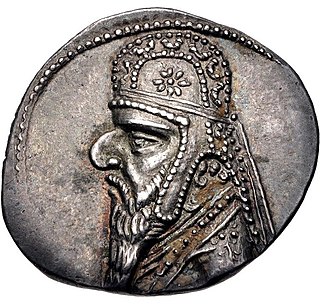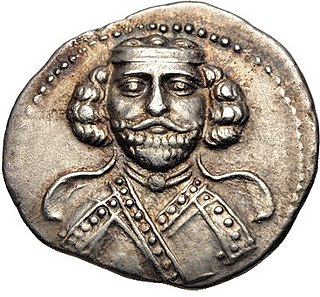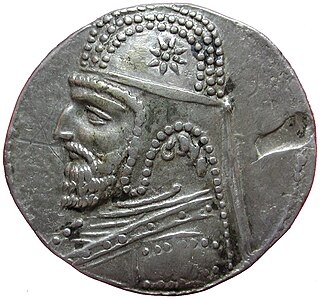Related Research Articles

Mithridates II was king of the Parthian Empire from 124 to 91 BC. Considered one of the greatest of his dynasty to ever rule, he was known as Mithridates the Great in antiquity.

Hyrcania is a historical region composed of the land south-east of the Caspian Sea in modern-day Iran and Turkmenistan, bound in the south by the Alborz mountain range and the Kopet Dag in the east.

Phraates III, was King of Kings of the Parthian Empire from 69 BC to 57 BC. He was the son and successor of Sinatruces.

Phraates IV was King of Kings of the Parthian Empire from 37 to 2 BC. He was the son and successor of Orodes II, and was given the throne after the death of his brother Pacorus I. Phraates IV soon murdered all his brothers, and also possibly his father. His actions alienated the Armenians and also some of his nobles, including the distinguished Monaeses, who fled to the Roman triumvir Mark Antony, but shortly returned and reconciled with Phraates IV.

Orodes II, was King of Kings of the Parthian Empire from 57 BC to 37 BC. He was a son of Phraates III, whom he murdered in 57 BC, assisted by his elder brother Mithridates IV. The two brothers quickly fell out and entered into a dynastic struggle, in which Orodes was triumphant.

Artabanus II, incorrectly known in older scholarship as Artabanus III, was King of Kings of the Parthian Empire from 12 to 38/41 AD, with a one-year interruption. He was the nephew and successor of Vonones I. His father has been variously identified as a Dahae or Atropatid prince, whilst his mother was a daughter of the Parthian King of Kings Phraates IV.

Vonones I was an Arsacid prince, who ruled as King of Kings of Parthian Empire from 8 to 12, and subsequently as king of Armenia from 12 to 18. He was the eldest son of Phraates IV and was sent to Rome as a hostage in 10/9 BC in order to prevent conflict over the succession of Phraates IV's youngest son, Phraataces.

Vonones II was a Parthian prince who ruled as king of Media Atropatene and briefly as king of the Parthian Empire.

Orodes I, was king of the Parthian Empire from 80 to 75 BC. He was the son and heir of Gotarzes I. His reign is relatively obscure. His throne may have been usurped in 87–80 BC by his supposed uncle Mithridates III, however, this has found little support in scholarship. Of his military activities, it is known that Orodes I re-established Parthian rule in Elymais in 78 BC, which had been independent since 81/80 BC. Orodes I later lost the throne to the aged Parthian prince Sinatruces, who belonged to a different branch of the royal Arsacid family.
The Arsacid dynasty, called the Arshakuni (Արշակունի) in Armenian, ruled the Kingdom of Armenia from 12 to 428 AD. The dynasty was a branch of the Arsacid dynasty of Parthia. Arsacid kings reigned intermittently throughout the chaotic years following the fall of the Artaxiad dynasty until 62, when Tiridates I, brother of Parthian King Vologases I, secured Arsacid rule in Armenia as a client king of Rome. However, he did not succeed in establishing his line on the throne, and various princes of different Arsacid lineages ruled until the accession of Vologases II, who succeeded in establishing his own line on the Armenian throne, which ruled the kingdom until its abolishment by the Sasanian Empire in 428.

The Parthian Empire, also known as the Arsacid Empire, was a major Iranian political and cultural power centered in ancient Iran from 247 BC to 224 AD. Its latter name comes from its founder, Arsaces I, who led the Parni tribe in conquering the region of Parthia in Iran's northeast, then a satrapy (province) under Andragoras, who was rebelling against the Seleucid Empire. Mithridates I greatly expanded the empire by seizing Media and Mesopotamia from the Seleucids. At its height, the Parthian Empire stretched from the northern reaches of the Euphrates, in what is now central-eastern Turkey, to present-day Afghanistan and western Pakistan. The empire, located on the Silk Road trade route between the Roman Empire in the Mediterranean Basin and the Han dynasty of China, became a center of trade and commerce.

The Twenty-seventh Dynasty of Egypt, also known as the First Egyptian Satrapy, was a satrapy of the Achaemenid Empire between 525 and 404 BC. It was founded by Cambyses II, the King of Persia, after the Battle of Pelusium and the Achaemenid conquest of Egypt, and his subsequent crowning as Pharaoh of Egypt. It was disestablished upon the rebellion and crowning of Amyrtaeus as Pharaoh. A second period of Achaemenid rule in Egypt occurred under the Thirty-first Dynasty of Egypt.

Mithridates III was king of the Parthian Empire from 87 to 80 BC. His existence is disputed in scholarship.
Persian war of succession may refer to:
The so-called "Parthian Dark Age" refers to a period of three decades in the history of Parthian Empire between the death of Mithridates II in 91 BC, and the accession to the throne of Orodes II in 57 BC, with various date ranges being mentioned by scholars. It is called a "Dark Age" due to a lack of clear information on the events of this period in the empire, except a series of, apparently overlapping, reigns.
References
- ↑ Assar, G.R.F., "Genealogy & Coinage of the Early Parthian Rulers. I", Parthica, 6, 2004, pp. 69-93.
- ↑ Assar, G.R.F., "A Revised Parthian Chronology of the Period 165-91 B.C.", Electrum, vol. 11, 2006, pp. 87-158. Ghashghai, H.R., "The successors of Mithridates II", Bulletin of Ancient Iranian History (UCLA), vol. 5, March 2009.
- ↑ Assar, G.R.F., "A Revised Parthian Chronology of the Period 165-91 B.C.", Electrum, vol. 11, 2006, pp. 87-158. Ghashghai, H.R., "The successors of Mithridates II", Bulletin of Ancient Iranian History (UCLA), vol. 5, March 2009.
- ↑ Assar, G.R.F., "A Revised Parthian Chronology of the Period 165-91 B.C.", Electrum, vol. 11, 2006, pp. 87-158. Ghashghai, H.R., "The successors of Mithridates II", Bulletin of Ancient Iranian History (UCLA), vol. 5, March 2009.
- ↑ Ghashghai, H.R., "The successors of Mithridates II", Bulletin of Ancient Iranian History (UCLA), vol. 5, March 2009.
- ↑ Ghashghai, H.R., "The successors of Mithridates II", Bulletin of Ancient Iranian History (UCLA), vol. 5, March 2009.
- ↑ Ghashghai, H.R., "The successors of Mithridates II", Bulletin of Ancient Iranian History (UCLA), vol. 5, March 2009.
- ↑ Josephus Flavius, Antiquities of the Jews, Book XVI, Ch.8.4
- ↑ Tacitus, The Annals, 11.10